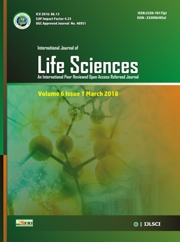RESEARCH ARTICLES
Volume 9 |Issue 4| July-August 2021 First published: 30 July 2021
Nagarkar SS Department of Botany, Adarsh Education Society’s Arts, Commerce and Science College, Hingoli 431513, MS, India.
E-mail: drssnagarkar@gmail.comBiochemical Analysis of Pollen Grains of Datura innoxia L.
for Screening its Allergenicity
Abstract
Keywords:Datura innoxia, biochemical analysis, allergenic pollen. Editor: Dr.Arvind Chavhan Cite this article as: 1. Basarkar, U.G. and Saoji, A.A. 2006. Qualitative and quantitative estimation of biochemicals from Parthenium hysterophorus L. pollen. Indian J. Aerobiol. 19: 79-83. 2. Stanley, R.G. and Linskens, H.F. 1974. Pollen: Biology, Biochemistry, Management. Springer, New York. 3. Chakraborty, P., Gupta-Bhattacharya, S. and Chanda, S. 1996. Comparative aerobiology, allergenicity and biochemistry of three palm pollen grains in Calcutta, India. Aerobiologia 12: 47-50. 4. Mondal, A.K., Parui, S. and Mandal, S. 1998A. Biochemical analysis of four species of Cassia L. pollen. Aerobiologia 14: 45-50. 5. Mondal, A.K., Parui, S. and Mandal, S. 1998B. Analysis of the free amino acid content in pollen of nine Asteraceae species of known allergenic activity. Ann. Agric. Environ. Med 5: 17-20. 6. Boral, D., Roy, L and Bhattacharya, K. 1999. Aerobiology, allergenicity and biochemistry of Madhuca indica Gmel. pollen. Ann. Agric. Environ. Med. 6: 87-90. 7. Parui, S. and Mandal, S. 1998. Biochemical analysis and skin sensitivity test of the allergenic pollen of Darura metal L. Current Science 74: 66-68. 8. Parui, S., Mondal, A.K. and Mandal, S. 1999. Identification and partial characterization of the allergenic proteins of Ricinus communis L. pollen - a new approach. Grana 38: 311-315. 9. Parui, S., Mondal, A.K. and Mandal, S. 2002. Identification of the allergenic proteins of Cassia siamea pollen. Grana 41: 39-43. 10. Miller, G.L. 1959. Use of dinitrosalicylic acid reagent for determination of reducing sugar. Anal. Chem. 31:426-428. 11. Yemm, E.W. and Willis, A.J. 1954. The estimation of carbohydrates in plant extracts by Anthrone. Biochem. 57: 508-514. 12. Kirk, P.L. 1950. Kjeldahl method for total nitrogen. Anal. Chem. 22: 354-358. 13. Somerville, D.C. 2005. Lipid content of honey bee-collected pollen from south-east Australia. Aus. J. Exp. Agric. 45: 1659- 1661. 14. Folch, J., Lees, M. and Sloane Stanley, G.H. 1957. A simple method for the isolation and purification of total lipides from animal tissues. J. Biol. Chem. 226: 497-509. 15. Human, H. and Nicolson, S. W. 2006. Nutritional content of fresh, bee-collected and stored pollen of Aloe greatheadii var. davyana (Asphodelaceae). Phytochemistry 67: 1486- 1492. 16. Dukhanina, I.V., Airapetov A.Yu., Lazaryan, G.D. and Vasilenko, Yu. K. 2006. Quantitative determination of free amino acids in pollen. Pharmaceutical Chemistry Journal 40: 82-84. 17. Sadasivam, S. and Manickam, A. 2005. Biochemical Methods. New Age International (P) Ltd. Pub's. India. 18. Baron, D.N. and Economidis, J. 1963. Thin-layer chromatography for amino-acids and sugars. J. Clin. Path. 16: 484-486. 19. Lowry, O.H., Rosebtough, N.J., Farr, A.L. and Randall, R.J. 1951. Protein measurement with the folin phenol reagent. J. Biol. Chem. 193: 265-275. 20. Todd, F.E. and Bretherick, O. 1942. The composition of pollen. J. Econ. Entomol. 35: 312-317.
Nagarkar SS. Biochemical Analysis of Pollen Grains of Datura innoxia L. for Screening its Allergenicity, Int. Res. Journal of Science & Engineering, 2021, Volume 9(4): 125-128.References

